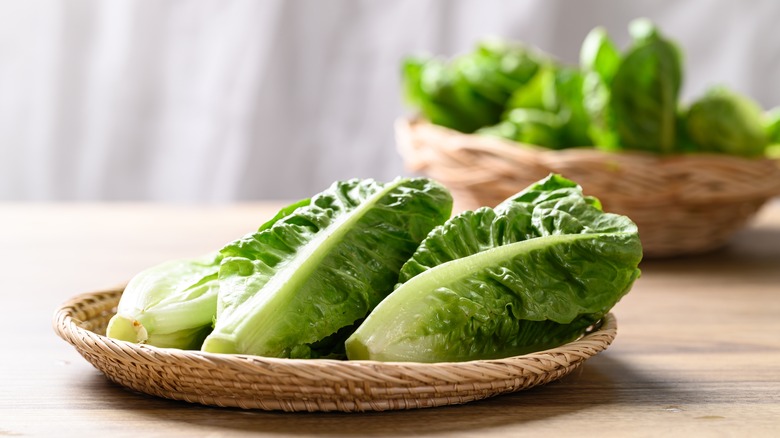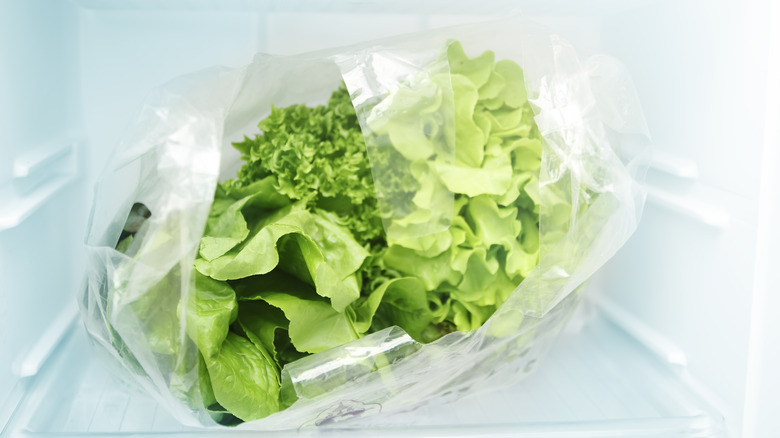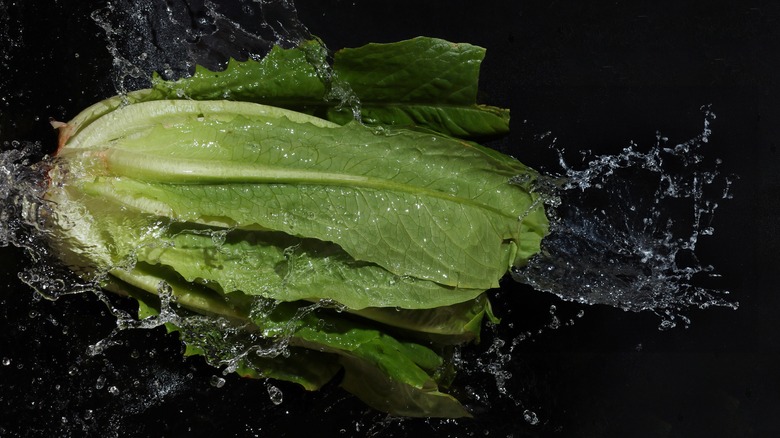The Storage Tips You Need For Fresh Romaine Lettuce
Romaine is one of the most popular lettuce varieties in the U.S. — its presence in restaurants and grocery stores is rivaled only by iceberg (although romaine is the better choice nutrition-wise). If you're a fan of salads like a classic Caesar, you probably have some romaine in your fridge right now. Unfortunately, it might be going bad in there, and fast. Lettuce can wilt in just a couple of days, turning from delightfully crisp to disturbingly soggy, but with the right storage techniques, you can stretch that shelf life to a couple of weeks.
Storing lettuce is all about regulating moisture. Romaine lettuce is about 94% water, so when it loses moisture, it shrivels up — that's how wilting happens. When lettuce is growing, it pulls up water from the soil to become healthy and crisp. However, once harvested, it loses that crucial water source, and has to survive on whatever water it has stored in its cells. Over time, that water is going to evaporate, essentially sucking the life out of the greens.
Grocery stores routinely spray mist on lettuce and other produce to help offset the moisture loss, but things get risky once you bring those greens home. Moisture evaporates quickly in the dry air of a refrigerator, and you have to fight that process to keep the lettuce fresh.
How to keep romaine lettuce crisp
The best way to store romaine lettuce begins with buying a fresh head. Whole heads of lettuce last much longer than bags of pre-cut lettuce, so it's best to skip the bagged stuff for the most longevity. To store a head of romaine, wrap it in a paper towel, which will absorb excess water (while lettuce needs some moisture on the surface, too much leads to rapid decay). Then, place the towel-wrapped lettuce in a perforated plastic bag.
This storage setup should achieve the right balance of moisture and air flow. It also helps to store lettuce in the crisper drawer of your refrigerator, which is built to regulate humidity. A head of romaine will last up to three weeks this way.
If you buy pre-cut romaine, the first thing you should do is pick out any damaged, brown, or wilted leaves. Then, wash the lettuce and dry it using a salad spinner. You can also dry lettuce without a salad spinner, if you don't have one. Pre-cut lettuce often comes in a plastic clamshell container or bag, but these are terrible storage vessels. They usually block air flow, building up excess moisture that can lead to mold and bacterial growth. Instead, put the lettuce in a perforated bag and store it in the crisper drawer. Romaine should last up to two weeks with this method.
How to make wilted lettuce crisp again
Even if you store romaine lettuce properly, there will come a time when it begins to wilt. If this ends up happening, don't throw out the greens just yet. With a little bit of kitchen magic, you might be able to restore their crispness. The first thing you'll need to do is pick out any leaves that have turned brown, or so wilted that they've turned to mush. The next step is to soak the lettuce in a bowl of hot water for 15 to 30 minutes.
It seems like basic common sense to soak lettuce in cold water to make it crisp again. After all, lettuce turns soft if you add it to a hot dish. But it turns out that warm water is actually more effective. A quick bath in hot (but not boiling) water can open the cell walls within the veggie, allowing it to soak up more moisture.
This technique is known as heat shocking, and it can make veggies firmer while slowing down browning and the risk of further wilting. However, it's best to use your romaine before it gets a chance to wilt again. Once the soaking period is over, you should dry the lettuce and put it back in the fridge just long enough to chill it, then use it immediately.


